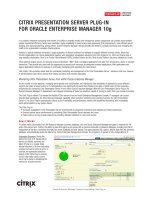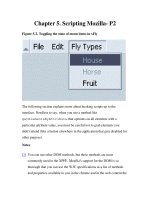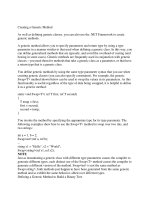Tài liệu Creating a Logical Standby Database by Using Enterprise Manager ppt
Bạn đang xem bản rút gọn của tài liệu. Xem và tải ngay bản đầy đủ của tài liệu tại đây (241.56 KB, 29 trang )
7
Copyright © 2006, Oracle. All rights reserved.
Creating a Logical Standby Database by Using
Enterprise Manager
Copyright © 2006, Oracle. All rights reserved.
7 - 2
Objectives
After completing this lesson, you should be able to do the
following:
•
Explain the advantages of SQL Apply
•
Explain when to use a logical standby database
•
Create a logical standby database by using Enterprise
Manager
Copyright © 2006, Oracle. All rights reserved.
7 - 3
Benefits of Implementing a
Logical Standby Database
•
Provides an efficient use of system resources:
–
Open, independent, and active production database
–
Additional indexes and materialized views can be created
for improved query performance.
•
Reduces workload on the primary database by
offloading the following workloads to a logical standby
database
–
Reporting
–
Summations
–
Queries
Copyright © 2006, Oracle. All rights reserved.
7 - 4
Benefits of Implementing a
Logical Standby Database
•
Provides data protection:
–
Primary database corruptions not propagated
•
Provides disaster recovery capabilities:
–
Switchover and failover
–
Minimizes downtime for planned and unplanned outages
Copyright © 2006, Oracle. All rights reserved.
7 - 5
Securing Your Logical Standby Database
•
Configure the database guard to control user access to
tables.
•
ALTER DATABASE GUARD command keywords:
–
ALL: prevents users from making changes to any data in
the database.
–
STANDBY: prevents users from making changes to any
data maintained by Data Guard SQL Apply.
–
NONE: normal security
•
Query GUARD_STATUS column in V$DATABASE.
•
Database guard level is set to ALL by broker
automatically on the logical standby database.
•
Database guard level applies to all users except SYS.
Copyright © 2006, Oracle. All rights reserved.
7 - 6
Preparing to Create a
Logical Standby Database
Perform the following steps on the primary database
before creating a logical standby database:
1. Check for unsupported data types.
2. Be aware of unsupported DDL commands.
3. Ensure row uniqueness.
4. Verify that the primary database is configured for
ARCHIVELOG mode.
5. Enable supplemental logging.
Copyright © 2006, Oracle. All rights reserved.
7 - 7
Unsupported Objects
•
Log apply services automatically exclude unsupported
objects when applying redo data to the logical standby
database.
•
Unsupported objects:
–
Tables and sequences in the SYS schema
–
Tables using table compression
–
Tables used to support materialized views
–
Global temporary tables
–
Tables with unsupported data types (see list on next page)
Copyright © 2006, Oracle. All rights reserved.
7 - 8
Unsupported Data Types
•
Log apply services automatically exclude tables with
unsupported data types when applying redo data to the
logical standby database.
•
Unsupported data types:
–
BFILE, ROWID, and UROWID
–
User-defined types
–
Object types REFs
–
Varrays
–
Nested tables
–
XMLtype
Copyright © 2006, Oracle. All rights reserved.
7 - 9
Checking for Tables with
Unsupported Data Types
Query DBA_LOGSTDBY_UNSUPPORTED on the primary
database for tables with unsupported data types:
SQL> desc DBA_LOGSTDBY_UNSUPPORTED
Name Null? Type
-------------- -------- -------------
OWNER NOT NULL VARCHAR2(30)
TABLE_NAME NOT NULL VARCHAR2(30)
COLUMN_NAME NOT NULL VARCHAR2(30)
DATA_TYPE VARCHAR2(106)
Copyright © 2006, Oracle. All rights reserved.
7 - 10
Unsupported DDL Commands
•
EXPLAIN
•
LOCK TABLE
•
SET CONSTRAINTS
•
SET ROLE
•
SET TRANSACTION
•
ALTER DATABASE
•
ALTER SESSION
•
ALTER MATERIALIZED VIEW
•
ALTER MATERIALIZED VIEW LOG
•
ALTER SYSTEM
•
CREATE CONTROL FILE
•
CREATE DATABASE
•
CREATE DATABASE LINK
•
CREATE PFILE FROM SPFILE
•
CREATE SCHEMA AUTHORIZATION
•
CREATE MATERIALIZED VIEW
•
CREATE MATERIALIZED VIEW LOG
•
CREATE SPFILE FROM PFILE
•
DROP DATABASE LINK
•
DROP MATERIALIZED VIEW
•
DROP MATERIALIZED VIEW LOG
Copyright © 2006, Oracle. All rights reserved.
7 - 11
Ensuring Unique Row Identifiers
•
Query DBA_LOGSTDBY_NOT_UNIQUE on the primary
database to find tables without a unique identifier:
•
BAD_COLUMN values:
–
Y: Data type is unbounded.
–
N: Table contains enough column information.
•
Add a primary key or unique index to ensure that SQL
Apply can efficiently apply data updates
SQL> desc DBA_LOGSTDBY_NOT_UNIQUE
Name Null? Type
-------------- -------- ------------
OWNER NOT NULL VARCHAR2(30)
TABLE_NAME NOT NULL VARCHAR2(30)
BAD_COLUMN VARCHAR2(1)









